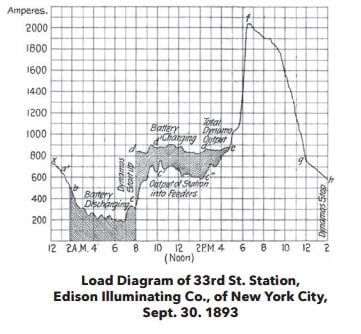This article is featured in the Edison Foundation Institute for Electric Innovation's full report, "Key Trends Driving Change in the Electric Power Industry, Volume II," and is available to download here.
Battery storage: it’s back to the future. More than 120 years ago, batteries were commonplace on the power grid. Thanks to Thomas Edison’s vision, many central station power plants and distribution networks utilized battery systems in the 1890s.
Today, battery-based energy storage is again becoming vital to our power system. Storage is needed for load balancing and a great deal more. Batteries can help achieve the reliable, affordable, and clean power grid of the future, in the U.S. and around the world.
This chart shows a 19th century “duck curve” for New York City, and demonstrates the key role that batteries played in smoothing the peaks and valleys of electricity demand throughout the day and night in Edison’s time.1
A SECTOR IN TRANSFORMATION
Electric companies have a reputation for being steady and unexciting enterprises, providing a service that is silent, invisible, and noticed only when it fails to deliver the energy that’s so essential to our personal lives and the entire economy. But the electric power industry is moving into a dynamic period of operating challenges and structural change, driven by innovations in technology, commodity markets, regulation, and security needs. Batteries can assist power system operations in this transformation in a variety of ways:
Improving the reliability of renewables.
Renewables are critical to the future of power generation. In the U.S., more than half of new capacity additions came from renewables last year.2 Globally, two-thirds of new power investments through 2040 are projected to be wind and solar.3 Greater renewable energy generation reduces the carbon intensity of our electric system. But, renewables are highly variable; small disruptions from clouds or wind bursts can create major challenges for the grid. Batteries can help balance supply and demand when the sun isn’t shining and the wind isn’t blowing. In fact, California utilities are already choosing to use battery-based storage as a competitive complement to their generation services and electric network investments to deal with the massive adoption of solar energy in the state, exceeding targets set by their regulators for energy storage.
Enhancing performance of traditional power generation.
By adding batteries to the existing generation fleet, we can hold less generation in reserve and produce more energy. Greater use of batteries can also facilitate more efficient operation of thermal units, reducing wear and tear and maintenance costs in the long run. These benefits have been realized in the northern region of Chile, where AES worked with the system operator to improve power plant output by four percent using batteries while simultaneously eliminating load-shedding and reducing the overall system cost by more than $30 million per year.
Easing transmission constraints and integrating distributed generation.
Our transmission system is only 50 percent utilized in the U.S. because of significant grid constraints during peak periods. Batteries can help match energy production with the times and places where it is needed most, no matter where the energy is generated. Better use of existing infrastructure reduces the need for near-term investment in transmission upgrades. Batteries can also provide a variety of ancillary services that grid operators increasingly need in today’s more complex power markets.
AES ENERGY STORAGE
AES is the world leader in lithium-ion based energy storage. AES has now released its fourth-generation battery energy storage system, Advancion®, which is available globally through alliance partners such as Eaton and Mitsubishi Corporation. Advancion combines eight years of designing, developing, and operating energy storage in one complete product that’s ready to serve for the long-term.
There are more than 384 megawatts (MW) of Advancion in operation, under construction, or in advanced development in seven countries: the United States, United Kingdom, Netherlands, Chile, India, the Philippines, and the Dominican Republic.
A SIMPLE PATH TO THE GRID OF THE FUTURE
To speed greater adoption of energy storage, our industry simply needs to include storage in planning and procurement processes and remove unnecessary barriers to its deployment. When utility systems are planned, when markets are designed, and— most important—when a procurement process is initiated, it makes sense to consider and include storage for the operational and economic advantages it offers.
In procurement processes, AES and our storage customers have shown that energy storage is competitive without special incentives. We have seen this with the Advancion fleet in PJM (one of the world’s largest wholesale power markets), a similar storage fleet in Chile, and, more recently, in California, where a competitive all-source procurement for capacity by Southern California Edison resulted in selection of more than five times the amount of energy storage that was expected, including a 100 MW Advancion energy storage array.
As more renewables are developed in the U.S. and globally, and as system operators seek the increased flexibility that batteries afford, it appears that Thomas Edison’s vision for an efficient battery-enabled power system will be achieved many times over in the 21st century.
Sources
1. Engineering News, Vol. 30, p 358, Nov. 2, 1893.
2. https://www.snl.com/InteractiveX/ Article.aspx?cdid=A-34950800-13103.
3. Bloomberg New Energy Finance, “2015 New Energy Outlook.”

















